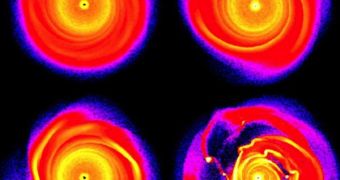Astronomers have finally admitted the existence of tier-2 planets. They have already developed a classification, and have included the new class of planets – called super-Earth – within datasets seeking to make sense of the way other star systems are set up.
As hundreds of extrasolar planets are discovered, researchers are becoming hard-pressed to find room within existing models for a type of planet that theoretically did not exist until now – the super-Earth.
These objects were not proposed to exist until now because observations of our own solar system led astronomers astray. When we look in our planet's surroundings, all we see are three rocky planets and four gas giants, with no intermediary-sized bodies to fill in the gap.
The existence of these objects, larger than rocky planets such as Earth and smaller than gas giants such as Neptune, Uranus, Jupiter and Saturn, has been hypothesized (and proven to some extent), but never widely adopted by the international astronomical community.
A super-Earth is a rocky planet that is nearly as large as Uranus. Studies conducted with exoplanet-detecting telescopes such as NASA's Kepler and the French CoRot have provided data on a number of alien worlds that meet this description.
The fact that this class of objects exists and is testable will have tremendous implications on future astronomical theory. Thus far, experts thought that there were no intermediary-sized planets, and as such sought to explain the mechanisms of planetary formation with these objects.
Now that they know the bodies exist, they will have to fit them into existing star system formation models, and that is not going to be easy, experts say. Until now, they had to explain why no hybrid planets ever developed, to share the traits of both rocky worlds and gas giants.
In a new scientific review published by University of Hawaii in Honolulu expert Nader Haghighipour, the issue of whether these worlds may sustain liquid water or not is being analyzed in detail.
The expert believes that worlds ranging in size from Earth to Uranus may keep thin atmospheres around them. An important aspect is that they most likely have liquid cores, that drive the creation of a magnetic field through the dynamo effect.
This implies that plate tectonic are also possible, which means that earthquakes, potential floods and volcanic eruptions can occur to. Chemicals such as sulfur are known for their ability to support life, and for the fact that they can be found in ash clouds in large amounts.
Therefore, Haghighipour says, all that is needed on such a world for water to exist is for it to be located in its parent star's habitable zone, and for it to have liquid water on the surface, Technology Review reports.

 14 DAY TRIAL //
14 DAY TRIAL //